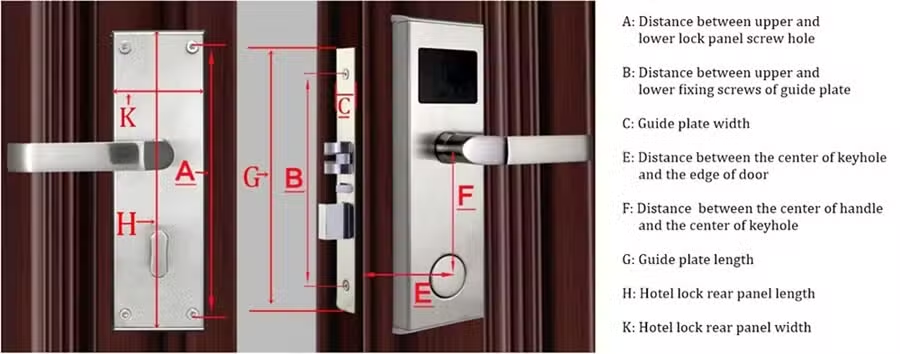The security of your home begins at your front door – literally. Understanding how to properly install a door lock is crucial for both safety and functionality. Whether you’re upgrading your existing lock or installing one for the first time, this comprehensive guide will walk you through the entire process with confidence.
At SRNLOCK, we’ve helped countless homeowners secure their properties with reliable, high-quality door locks. As Sally, the overseas sales manager at SRN TECH, I’ve witnessed firsthand how proper installation can make the difference between a lock that serves you well for years and one that causes endless frustration. In this guide, we break down the installation process step-by-step, ensuring you achieve professional results every time.
Choosing the Right Lock for Your Door
Before diving into installation, selecting the appropriate lock for your specific door and security needs is essential. The wrong choice can lead to installation difficulties and compromised security.
Types of Door Locks
Understanding the different types of door locks available will help you make an informed decision.
Cylindrical locks are the most common choice for residential applications, featuring a knob or lever handle with an integrated locking mechanism. These locks are relatively easy to install and suitable for most standard doors.
Deadbolt locks provide enhanced security and are often used in combination with cylindrical locks. They extend deeper into the door frame, making forced entry significantly more difficult. Single-cylinder deadbolts use a key on the outside and a thumb turn on the inside, while double-cylinder deadbolts require a key on both sides.
Smart locks represent the latest in home security technology, offering keyless entry through keypads, smartphones, or biometric sensors. While installation follows similar principles to traditional locks, these may require additional considerations for power sources and connectivity.
Mortise locks are commonly found in commercial applications and older homes. They require a pocket (mortise) to be cut into the door and typically offer superior security and durability compared to cylindrical locks.
Necessary Tools for Installation
Having the right tools readily available will make your installation process smooth and efficient. You’ll need a drill with various bit sizes, including a hole saw attachment for creating the larger lock body hole.
A chisel set is essential for creating clean, precise recesses for the lock faceplate and strike plate.
Measuring tools, including a tape measure and pencil, will help ensure accurate placement.
A screwdriver set with both flathead and Phillips head options is crucial for securing components.
Don’t forget safety equipment such as safety glasses and work gloves to protect yourself during the installation process.
Preparing Your Door
Proper preparation sets the foundation for a successful installation. Taking time to prepare correctly will save you from costly mistakes and ensure your lock functions perfectly.
Checking Door Measurements
Before beginning any installation work, verify that your door can accommodate the lock you’ve chosen. Standard door thickness ranges from 1⅜ inches to 1¾ inches, and most residential locks are designed for this range. Measure your door thickness at several points to ensure consistency.
Door swing direction is equally important. Stand on the side of the door where the hinges are visible – if the hinges are on your right, you have a right-hand door. If they’re on your left, it’s a left-hand door. This information is crucial for proper lock orientation and strike plate alignment.
Check the existing door preparation if you’re replacing a lock. Measure the diameter of existing holes and their distance from the door edge. Standard backset measurements are either 2⅜ inches or 2¾ inches from the door edge to the center of the lock hole.
Gathering Necessary Tools
Beyond the basic tools mentioned earlier, ensure you have additional supplies that might be needed during installation. Wood filler can help repair any mistakes or fill unused screw holes from previous locks. Sandpaper allows you to smooth rough edges after drilling or chiseling.
Lubricants such as graphite or silicone spray will help ensure smooth operation of your newly installed lock. Keep spare screws of various lengths on hand, as door thickness variations sometimes require different screw lengths than those provided with the lock.

Step-by-Step Installation Process
Now comes the hands-on portion of your door lock installation. Following these steps carefully will ensure professional results and optimal security.
Marking the Spot for Your Lock
Precise marking is crucial for a clean, professional installation. Measure and mark the center point for your lock hole, typically 36 inches from the floor for standard installations. Use the paper template provided with your lock, or create your own measurements.
Mark the backset distance from the door edge to ensure proper alignment with the strike plate on the door frame. Double-check all measurements before proceeding, as drilling mistakes can be costly to repair.
Use a center punch or nail to create a small indentation at your marked center point. This prevents the drill bit from wandering when you begin drilling and ensures accuracy.
Drilling the Required Holes
Start with the larger hole for the lock body using a hole saw attachment. Drill from one side of the door until the pilot bit just breaks through the opposite side, then complete the hole from the other side. This technique prevents splintering and ensures a clean exit hole.
Drill the smaller hole for the bolt mechanism from the door edge, ensuring it intersects perfectly with the larger hole. Take your time with this step, as proper alignment is critical for smooth lock operation.
Test fit your lock components in the drilled holes before proceeding. The lock body should sit flush with the door surface, and the bolt should extend and retract smoothly without binding.
Inserting and Securing the Lock Mechanism
Insert the bolt mechanism into the edge hole first, ensuring the bolt face sits flush with the door edge. You may need to chisel a shallow recess for the bolt faceplate to achieve a flush fit.
Install the lock body by inserting it through the larger hole and connecting it to the bolt mechanism according to the manufacturer’s instructions. Most locks have alignment marks or specific orientation requirements that must be followed precisely.
Secure all components with the provided screws, but don’t fully tighten them until you’ve verified proper alignment and operation. Test the lock mechanism several times before final tightening.
Installing the Strike Plate on the Door Frame
Mark the strike plate location on the door frame by closing the door and marking where the bolt contacts the frame. The bolt should align perfectly with the center of the strike plate opening.
Chisel the strike plate recess carefully, creating a shallow depression that allows the strike plate to sit flush with the door frame surface. A properly installed strike plate not only looks professional but also provides maximum security.
Drill pilot holes for the strike plate screws to prevent splitting the door frame wood. Use screws that are long enough to penetrate well into the frame but not so long that they interfere with wall construction behind the frame.
Testing the Lock Functionality
Thoroughly test the lock operation before considering the installation complete. The bolt should extend and retract smoothly without binding or sticking. The door should close easily and latch securely without requiring excessive force.
Check key operation if applicable, ensuring the key turns smoothly and the lock engages properly. Test both sides of the door if you have a double-cylinder lock.
Verify security by attempting to push or pull the door open when locked. A properly installed lock should hold the door securely closed without any movement or rattling.
Troubleshooting Common Issues Even with careful installation, you may encounter some common issues that require adjustment or correction.
Adjusting Misaligned Locks
Bolt alignment problems are among the most common issues encountered during installation. If the bolt doesn’t align properly with the strike plate, check that all measurements were accurate and that the door hasn’t sagged on its hinges.
Minor adjustments can often be made by slightly enlarging the strike plate opening or adjusting the strike plate position. For more significant misalignment, you may need to plug and re-drill the bolt hole.
Door sagging can cause alignment issues even with a perfectly installed lock. Check the door hinges and adjust or replace them if necessary to restore proper door alignment.
Ensuring Smooth Lock Operation
Rough or sticky operation often indicates that the lock components aren’t properly aligned or that debris has interfered with installation. Disassemble the lock and check for any obstructions or misaligned parts.
Lubrication can resolve many operational issues, but use the appropriate type of lubricant for your lock type. Graphite works well for most traditional locks, while silicone spray is better for locks with plastic components.
Temperature and humidity changes can affect lock operation, particularly in exterior doors. Allow for some seasonal adjustment and consider using locks designed for exterior use in harsh climates.
Dealing with Sticking Keys
Key issues can stem from several sources, including rough key cuts, debris in the lock cylinder, or improper lock installation. Start by trying a duplicate key to determine if the problem is with the key or the lock.
Clean the lock cylinder carefully using compressed air or a specialized lock cleaner. Avoid using oil-based lubricants in the cylinder, as they can attract dirt and cause more problems over time.
Professional key cutting may be necessary if your keys were poorly cut initially. A locksmith can often resolve key issues that persist after proper installation and cleaning.
Tips for Enhanced Security
Beyond basic installation, consider these additional measures to maximize your home’s security.
Considering Deadbolts
Adding a deadbolt to your door significantly increases security, especially when combined with a quality door lock. Deadbolts are harder to force and provide an additional barrier against break-in attempts.
Grade 1 deadbolts offer the highest level of security and are tested to withstand significant force. While they cost more initially, the enhanced security is worth the investment for most homeowners.
Installation considerations for deadbolts are similar to regular locks but may require additional door preparation. Ensure your door and frame can accommodate the additional hardware without compromising structural integrity.
Regular Maintenance for Longevity
Routine maintenance extends the life of your door lock and ensures continued, reliable operation. Clean the lock exterior regularly and lubricate moving parts according to the manufacturer’s recommendations.
Seasonal adjustments may be necessary as doors and frames expand and contract with temperature and humidity changes. Keep an eye on lock operation and make minor adjustments as needed.
Professional servicing every few years can identify potential issues before they become major problems. A qualified locksmith can perform maintenance tasks that aren’t suitable for homeowner DIY efforts.
Conclusion
Installing a door lock might initially seem daunting, but with the right tools, quality components, and careful attention to detail, it’s a task that any homeowner can tackle successfully. The key to success lies in proper preparation, accurate measurement, and patient execution of each step.
At SRNLOCK, we’re committed to providing not just high-quality door locks but also the knowledge and support you need for successful installation. Our locks are designed with the DIY installer in mind, featuring clear instructions and quality components that make installation straightforward.
Remember to test your lock multiple times after installation and maintain it regularly for optimal security and longevity. A properly installed and maintained door lock provides years of reliable service and peace of mind.
Whether you’re securing a new home or upgrading your existing security, taking the time to install your door lock correctly is an investment in your family’s safety and your property’s protection. With these guidelines and quality SRNLOCK products, you’re well-equipped to achieve professional installation results.
For additional support, technical questions, or to explore our complete range of door lock solutions, visit us at www.srnlock.com. Our team at SRN TECH is always ready to help you find the perfect security solution for your needs.
You can also download the detailed manual from our download page: https://www.srnlock.com/download/.




